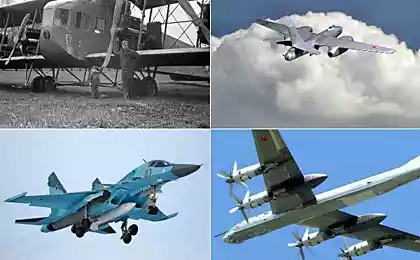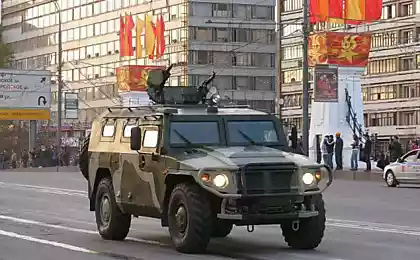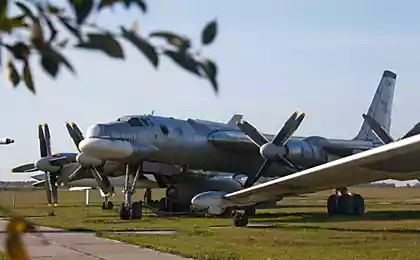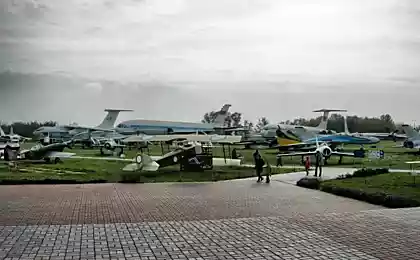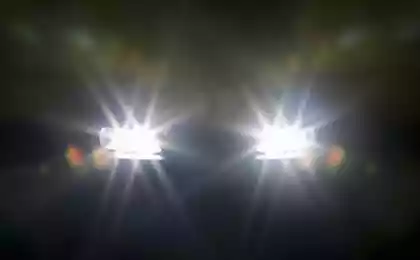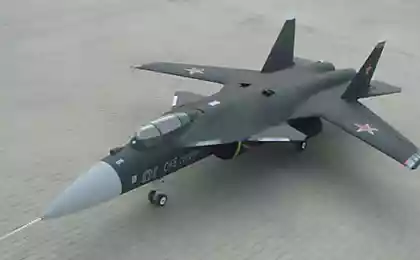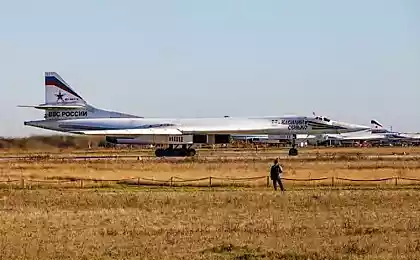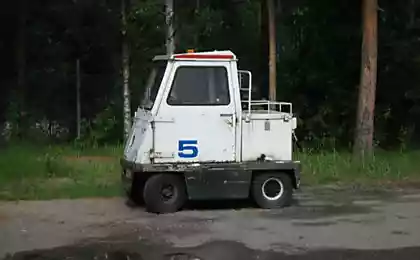711
Far supersonic missile-bomber with variable geometry wings.
Tu-22M (NATO: Backfire) - long-range supersonic bomber bomber with variable geometry wings.
By the mid-1960s, the trend in the field of combat use of long-range aviation identified low effectiveness of single-mode supersonic heavy bombers. It was necessary to create a multi-mode aircraft capable of performing combat missions in a wide range of altitudes and speeds. This goal could be achieved, first of all, the use of variable wing sweep in flight.
Work on the project this far-impact aircraft Tupolev began in 1965. At first, work was carried out without funding from the state budget on the basis of initiative and marketed solely as a deep modernization of the Tu-22K. At this stage of design engineering were already tested on planes TU-22 engines with the placement of the fuselage on both sides of the keel. Alterations concerned almost exclusively of future aircraft wing. However, by 1967 a number of technical reasons for the construction of Tu-22M has been completely revised and a new prototype bomber aircraft lost resemblance to the predecessor. It appears variant of the Tu-22M and mid-wing air intakes on the sides of the fuselage and engine placement in the tail part.
This version of the design, with some modifications was the basis for a future series of Tu-22M. It emphasizes continuity with the first supersonic heavy bomber Tu-22.
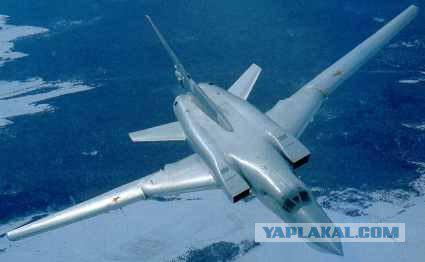
Common design features
Tu-22M
Aircraft Tu-22M series made by the normal aerodynamic scheme cantilever mid with variable sweep wing. The wing consists of a fixed part and a swivel arm. Wing sweep varies smoothly from 20 ° to 60 ° (Tu-22M3 - up to 65 °) with locking in any intermediate position. Mechanization of the wing slats includes, trёhsektsionnye slotted flaps, trёhsektsionnye spoilers, ailerons are not available. The aircraft has a semi-monocoque fuselage and retractable tricycle landing gear with a nose strut. The power plant consists of 2 turbofans NK-25, Tu-22M3 (airplanes first series NC-144-22). Air intakes with a vertical wedge (Tu-22M3 - horizontal) are located on the sides of the fuselage. Fuel capacity located in the integral tanks in the front (1, 2 tanks), medium (3, 4, 5) and the tail (6, 7, 8, cans) of the fuselage, a tail fin (9, tank) and the wing tanks, including the rotating part of the wing (console). In the rear suspension components are 2 starting solid accelerators.
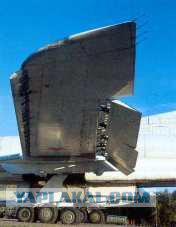
Combat application
Limits apply at the end of the Afghan war (1988-1989), as well as at an early stage of the first war in Chechnya.
During the war in South Ossetia in August 2008, one Tu-22M3 was shot down by Georgian air defense unit [1], presumably through the SAM "Buk" of the Ukrainian production. The use of such aircraft within range of enemy air defenses were not entirely justified, declared that the Deputy Chief of the General Staff of the Russian Armed Forces. [2]
Officially it reported that the aircraft carried out reconnaissance flight. In this case, it could be any of the Tu-22M3-R (based Ahtubinsk) or on the Tu-22MZ with intelligence instead Refuse bomb load [3]. The plane was piloted by a crew of 52 th Heavy Bomber Regiment, based in Shaykovka [4], which speaks in favor of the second version.

Performance characteristics (for the Tu-22M3)
[edit] Specifications
* Crew:
o 4 people:
commander
copilot
navigator navigator
navigator-operator
* Wingspan:
o straightened (20 °): 34, 28 m
o Addition (65 °): 23, 30 m
* Length: 41, 46 m
* Height: 11 05 m
* Wing area:
o straightened (20 °): 183, 57 m²
o Addition (65 °): 175, 80 m²
* Weight:
o empty aircraft: 78,000 kg
o normal takeoff: 112,000 kg
o maximum takeoff: 126000 kg
* Fuel weight: 53550 kg
* Engines :: 2 turbofans NK-25
* Link:
o besforsazhny 2 × 14500 kgs each
o afterburner 2 × 25,000 kgs each

Armament
One dvuhstvolny gun GSH-23L 23 mm at the rear of the turret; three Kh-22 (AS-4 'Kitchen') or four Kh-15P (AS-16 "Kikbek") on the pylons under the wing root, six Kh-15P in a rotary launcher in the weapons bay or bombs weighing up to 24000 kg (52910 lb) both inside and bomb racks under the air intakes; normal combat load is two Kh-22 or bombs weighing up to 12,000 kg (26,455 pounds).
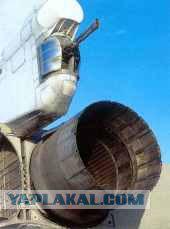
More

Source:
By the mid-1960s, the trend in the field of combat use of long-range aviation identified low effectiveness of single-mode supersonic heavy bombers. It was necessary to create a multi-mode aircraft capable of performing combat missions in a wide range of altitudes and speeds. This goal could be achieved, first of all, the use of variable wing sweep in flight.
Work on the project this far-impact aircraft Tupolev began in 1965. At first, work was carried out without funding from the state budget on the basis of initiative and marketed solely as a deep modernization of the Tu-22K. At this stage of design engineering were already tested on planes TU-22 engines with the placement of the fuselage on both sides of the keel. Alterations concerned almost exclusively of future aircraft wing. However, by 1967 a number of technical reasons for the construction of Tu-22M has been completely revised and a new prototype bomber aircraft lost resemblance to the predecessor. It appears variant of the Tu-22M and mid-wing air intakes on the sides of the fuselage and engine placement in the tail part.
This version of the design, with some modifications was the basis for a future series of Tu-22M. It emphasizes continuity with the first supersonic heavy bomber Tu-22.

Common design features
Tu-22M
Aircraft Tu-22M series made by the normal aerodynamic scheme cantilever mid with variable sweep wing. The wing consists of a fixed part and a swivel arm. Wing sweep varies smoothly from 20 ° to 60 ° (Tu-22M3 - up to 65 °) with locking in any intermediate position. Mechanization of the wing slats includes, trёhsektsionnye slotted flaps, trёhsektsionnye spoilers, ailerons are not available. The aircraft has a semi-monocoque fuselage and retractable tricycle landing gear with a nose strut. The power plant consists of 2 turbofans NK-25, Tu-22M3 (airplanes first series NC-144-22). Air intakes with a vertical wedge (Tu-22M3 - horizontal) are located on the sides of the fuselage. Fuel capacity located in the integral tanks in the front (1, 2 tanks), medium (3, 4, 5) and the tail (6, 7, 8, cans) of the fuselage, a tail fin (9, tank) and the wing tanks, including the rotating part of the wing (console). In the rear suspension components are 2 starting solid accelerators.

Combat application
Limits apply at the end of the Afghan war (1988-1989), as well as at an early stage of the first war in Chechnya.
During the war in South Ossetia in August 2008, one Tu-22M3 was shot down by Georgian air defense unit [1], presumably through the SAM "Buk" of the Ukrainian production. The use of such aircraft within range of enemy air defenses were not entirely justified, declared that the Deputy Chief of the General Staff of the Russian Armed Forces. [2]
Officially it reported that the aircraft carried out reconnaissance flight. In this case, it could be any of the Tu-22M3-R (based Ahtubinsk) or on the Tu-22MZ with intelligence instead Refuse bomb load [3]. The plane was piloted by a crew of 52 th Heavy Bomber Regiment, based in Shaykovka [4], which speaks in favor of the second version.

Performance characteristics (for the Tu-22M3)
[edit] Specifications
* Crew:
o 4 people:
commander
copilot
navigator navigator
navigator-operator
* Wingspan:
o straightened (20 °): 34, 28 m
o Addition (65 °): 23, 30 m
* Length: 41, 46 m
* Height: 11 05 m
* Wing area:
o straightened (20 °): 183, 57 m²
o Addition (65 °): 175, 80 m²
* Weight:
o empty aircraft: 78,000 kg
o normal takeoff: 112,000 kg
o maximum takeoff: 126000 kg
* Fuel weight: 53550 kg
* Engines :: 2 turbofans NK-25
* Link:
o besforsazhny 2 × 14500 kgs each
o afterburner 2 × 25,000 kgs each

Armament
One dvuhstvolny gun GSH-23L 23 mm at the rear of the turret; three Kh-22 (AS-4 'Kitchen') or four Kh-15P (AS-16 "Kikbek") on the pylons under the wing root, six Kh-15P in a rotary launcher in the weapons bay or bombs weighing up to 24000 kg (52910 lb) both inside and bomb racks under the air intakes; normal combat load is two Kh-22 or bombs weighing up to 12,000 kg (26,455 pounds).

More

Source:




